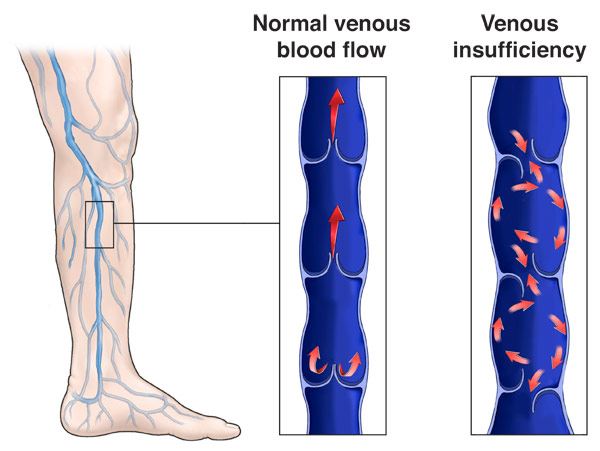Chronic Venous Insufficiency
Chronic Venous Insufficiency (CVI) is a condition that occurs when the venous wall and/or valves in the leg veins are not working effectively. Normally, the valves in your veins make sure that blood flows toward your heart. But when these valves don’t work well, blood can also flow backwards. This can cause blood to collect (pool) in your legs. Chronic venous insufficiency is not a serious health threat. But it can be painful and disabling.

Medical Illustration Copyright © 2019 Nucleus Medical Media, All rights reserved.
Causes of Chronic Venous Insufficiency
There’s no specific cause for CVI. However, other conditions, traits or habits may also play a role in raising your risk. These conditions are known as risk factors.
Non-Modifiable Risk Factors: These factors are irreversible and cannot be changed. The more of these risk factors you have, the greater your chance of developing this condition.
- Family History/Genetics
- Pregnancy
Modifiable Risk Factors: These factors can be modified, treated or controlled through medications or lifestyle changes.
- Long history of cigarette smoking and/or drug abuse.
- Obesity or having a body mass index “BMI” of 30 or greater.
- High blood pressure
- Little to no physical activity.
Other conditions that contribute to the development of CVI:
- Deep vein thrombosis
- Damage to your leg due to injury, surgery, or previous blood clots.
- Swelling and inflammation of a vein close to the skin, often in the legs (phlebitis).
Symptoms of Chronic Venous Insufficiency
Symptoms of CVI may vary. Common symptoms of CVI include the following:
- Swelling in your legs or ankles.
- Tight feeling in your calves or itchy, painful legs.
- Pain when walking.
- Brown-colored skin, often near the ankles.
- Varicose veins
- Having an urge to move your legs (restless legs syndrome).
- Painful leg cramps or muscle spasms (charley horse).
Diagnosis of Chronic Venous Insufficiency
To diagnose CVI, your doctor will ask you about your symptoms. You'll also have a physical exam so that your doctor can check for areas of swelling, tenderness or discoloration on your skin. You may also have one or more of the following diagnostic tests and procedures:
Treatment of Chronic Venous Insufficiency
There are several treatment options for CVI. These include lifestyle changes, medications, and medical and surgical procedures.
Lifestyle Changes
- Keeping your legs raised (elevated) can reduce swelling and help increase blood flow.
- Wear compression stockings.
- Exercise under the directions of your doctor.
- If you’re overweight, talk to your doctor about weight-loss options.
- Make and keep appointments to see your doctor for routine check-ups and follow-up tests.
Medications
- Aspirin will treat pain and inflammation.
- Diuretics “water pills” will help reduce the amount of fluid retention in your body.
